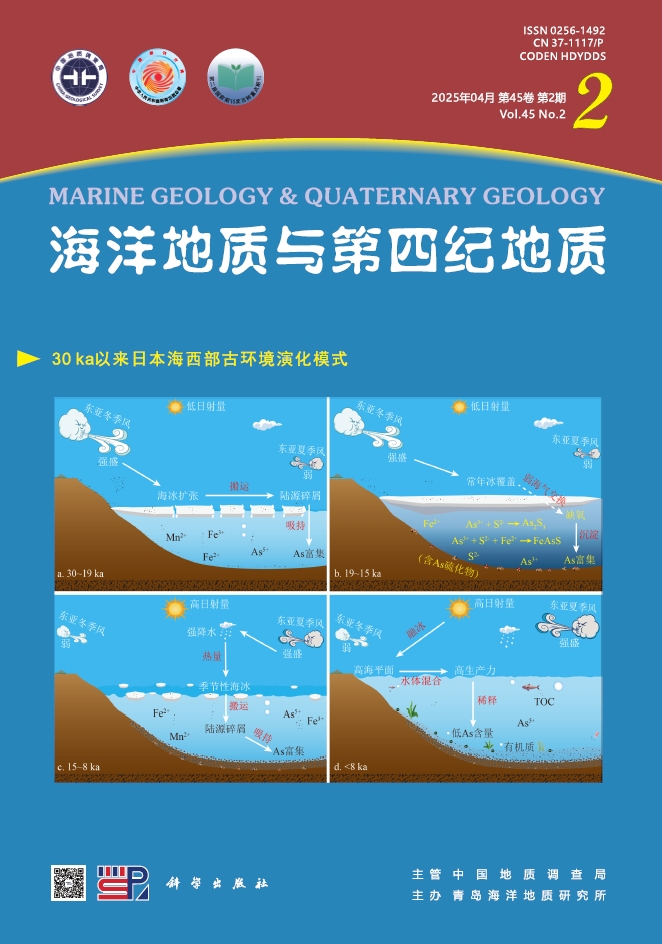| [1] |
An Z S, Porter S C, Kutzbach J E, et al. Asynchronous Holocene optimum of the East Asian monsoon[J]. Quaternary Science Reviews, 2000, 19(8):743-762.
Google Scholar
|
| [2] |
He Y, Theakstone W H, Zhang Z L, et al. Asynchronous Holocene climatic change across China[J]. Quaternary Research, 2004, 61:52-63.
Google Scholar
|
| [3] |
Dong J G, Wang Y J, Cheng H, et al. A high-resolution stalagmite record of the Holocene East Asian monsoon from Mt Shennongjia, central China[J]. The Holocene, 2010, 20(2):257-264.
Google Scholar
|
| [4] |
Fleitmann D, Burns S J, Manginic A, et al. Holocene ITCZ and Indian monsoon dynamics recorded in stalagmites from Oman and Yemen (Socotra)[J]. Quaternary Science Reviews, 2007, 26:170-188.
Google Scholar
|
| [5] |
Hong Y T, Hong B, Lin Q H, et al. Synchronous climate anomalies in the western North Pacific and North Atlantic regions during the last 14000 years[J]. Quaternary Science Reviews, 2009, doi:10.1016/j.quascirev.2008.11.011.
Google Scholar
|
| [6] |
Jiang W Y, Guo Z T, Sun X J, et al. Reconstruction of climate and vegetation changes of Lake Bayanchagan (Inner Mongolia):Holocene variability of the East Asian monsoon[J]. Quaternary Research, 2006, 65:411-420.
Google Scholar
|
| [7] |
Jung S J A, Davies G R, Ganssen G M, et al. Synchronous Holocene sea surface temperature and rainfall variations in the Asian monsoon system[J]. Quaternary Science Reviews, 2004, 23:2207-2218.
Google Scholar
|
| [8] |
Cai Y J, Tan L C, Cheng H, et al. The variation of summer monsoon precipitation in central China since the last deglaciation[J]. Earth and Planetary Science Letters, 2010, 291:21-31.
Google Scholar
|
| [9] |
Yancheva G, Nowaczyk N R, Mingram J, et al. Influence of the intertropical convergence zone on the East Asian monsoon[J]. Nature, 2007, 445:74-77.
Google Scholar
|
| [10] |
Tan L C, Cai Y J, Cheng H, et al. Summer monsoon precipitation variations in central China over the past 750 years derived from a high-resolution absolute-dated stalagmite[J]. Palaeogeography, Palaeoclimatology, Palaeoecology, 2009, 280:432-439.
Google Scholar
|
| [11] |
Tan M, Liu T S,Hou J Z, et al. Cyclic rapid warming on centennial-scale revealed by a 2650-year stalagmite record of warm season temperature[J]. Geophysical Research Letters, 2003,30(12):1617-1620.
Google Scholar
|
| [12] |
Zhang P Z, Cheng H, Edwards R L, et al. A test of climate, sun, and culture relationships from an 1810-year Chinese cave record[J]. Science, 2008, 322:940-942.
Google Scholar
|
| [13] |
Hu C Y, Henderson G M, Huang J H, et al. Quantification of Holocene Asian monsoon rainfall from spatially separated cave records[J]. Earth and Planetary Science Letters, 2008, 266:221-232.
Google Scholar
|
| [14] |
Wang Y J, Cheng H, Edwards R L, et al. The Holocene Asian Monsoon:links to solar changes and North Atlantic climate[J].Science,2005,308:854-857.
Google Scholar
|
| [15] |
Qian W, Lin X. Regional trends in recent precipitation indices in China[J]. Meteorology and Atmospheric Physics, 2005, 90:193-207.
Google Scholar
|
| [16] |
Steinhilber F, Beer J, Fr hlich C. Total solar irradiance during the Holocene[J]. Geophys Res.Lett., 2009, 36, L19704, doi:10.1029/2009GL040142.
Google Scholar
|
| [17] |
Stuiver M, Braziunas T F. Sun, ocean, climate and atmospheric 14CO2:an evaluation of causal and spectral relationships[J]. The Holocene,1993, 3(4):289-305.
Google Scholar
|
| [18] |
Rind D. The sun's role in climate variations[J]. Science, 2002, 296:673-677.
Google Scholar
|
| [19] |
Geel B V, Raspopov O M, Renssen H, et al. The role of solar forcing upon climate change[J]. Quaternary Science Reviews, 1999, 18:331-338.
Google Scholar
|
| [20] |
Julien Emile-Geay, Mark Cane, Richard Seager, et al. El Niño as a mediator of the solar influence on climate[J]. Paleoceanography, 2007, 22(3):3210-3221.
Google Scholar
|
| [21] |
Dorale J A, Gonzalez L A, Reagan M K, et al. A high-resolution record of Holocene climate change in speleothem calcite from Coldwater cave, Northeast Iowa[J]. Science, 1992, 258:1626-1630.
Google Scholar
|
| [22] |
Genty D, Blamart D, Ouahdi R, et al. Precise dating of Dansgaard-Oeschger climate oscillations in western Europe from stalagmite data[J]. Nature, 2003, 421:833-837.
Google Scholar
|
| [23] |
Genty D, Baker A, Massault M, et al. Dead carbon in stalagmites:Carbonate bedrock paleodissolution vs. ageing of soil organic matter. Implications for 13C variations in speleothems[J]. Geochimica et Cosmochimica Acta, 2001, 65(20):3443-3457.
Google Scholar
|
| [24] |
Genty D. Palaeoclimate research in Villars cave (Dordogne,SW-France)[J]. International Journal of Speleology, 2008, 37(3):173-191.
Google Scholar
|
| [25] |
Couchoud I, Genty D, Hoffmann D, et al. Millennial-scale climate variability during the Last Interglacial recorded in a speleothem from south-western France[J]. Quaternary Science Review, 2010, doi:10.1016/j.quascirev.2009.08.014.
Google Scholar
|
| [26] |
罗维均, 王世杰, 刘秀明. 洞穴现代沉积物δ13C值的生物量效应及机理探讨:以贵州4个洞穴为例[J]. 地球化学, 2007, 36(4):344-350.
Google Scholar
[LUO Weijun, WANG Shijie, LIU Xiuming. Biomass effect on carbon isotope ratio of modern calcite deposition and its mechanism:A case study of 4 caves in Guizhou Province, China[J]. Geochimica, 2007, 36(4):344-350.]
Google Scholar
|
| [27] |
邱红烈. 中国福建省亚热带山地4000年来植被变化的孢粉记录[J]. 亚热带资源与环境学报, 2006,1(1):11-23.
Google Scholar
[QIU Honglie. A 4000-year pollen record of vegetation change from the subtropical mountains of Fujian Province, China[J]. Journal of Subtropical Resources and Environment, 2006, 1(1):11-23.]
Google Scholar
|
| [28] |
刘申,罗艳,黄钰辉,等. 鼎湖山五种植被类型群落生物量及其径级分配特征[J]. 生态科学, 2007, 26(5):387-393.
Google Scholar
[LIU Shen, LUO Yan, HUANG Yuhui, et al. Studies on the community biomass and its allocations of five forest types in Dinghushan nature reserve[J]. Ecological Science, 2007, 26(5):387-393.]
Google Scholar
|






 DownLoad:
DownLoad: